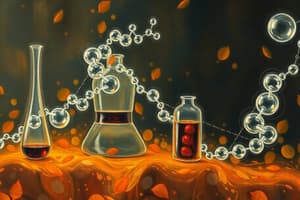Podcast
Questions and Answers
What is the main end product of glycolysis in the presence of oxygen?
What is the main end product of glycolysis in the presence of oxygen?
- Acetyl-CoA
- Glucose
- Pyruvate (correct)
- Lactate
Which type of glycolysis occurs in the absence of oxygen?
Which type of glycolysis occurs in the absence of oxygen?
- Fermentative glycolysis
- Anaerobic glycolysis (correct)
- Aerobic glycolysis
- Oxidative glycolysis
Which enzyme is responsible for converting fructose-6-phosphate to fructose-1,6-bisphosphate?
Which enzyme is responsible for converting fructose-6-phosphate to fructose-1,6-bisphosphate?
- Phosphofructokinase (correct)
- Aldolase
- Glyceraldehyde-3-phosphate dehydrogenase
- Hexokinase
In glycolysis, how many ATP molecules are net produced during anaerobic conditions?
In glycolysis, how many ATP molecules are net produced during anaerobic conditions?
What key role does glycolysis serve in red blood cells (RBCs)?
What key role does glycolysis serve in red blood cells (RBCs)?
Which compound is produced from glyceraldehyde-3-phosphate in glycolysis?
Which compound is produced from glyceraldehyde-3-phosphate in glycolysis?
What is one physiological importance of glycolysis in skeletal muscle tissue?
What is one physiological importance of glycolysis in skeletal muscle tissue?
What is the primary end product of aerobic glycolysis?
What is the primary end product of aerobic glycolysis?
Which of the following statements is true regarding the ATP production from glucose during aerobic glycolysis?
Which of the following statements is true regarding the ATP production from glucose during aerobic glycolysis?
Which enzyme is exclusively found in the liver that converts glucose?
Which enzyme is exclusively found in the liver that converts glucose?
What is the fate of pyruvate in anaerobic glycolysis?
What is the fate of pyruvate in anaerobic glycolysis?
How many ATP are generally produced from anaerobic glycolysis?
How many ATP are generally produced from anaerobic glycolysis?
What is a biological importance of glycolysis in relation to oxygenation of tissues?
What is a biological importance of glycolysis in relation to oxygenation of tissues?
Which statement about hexokinase is correct?
Which statement about hexokinase is correct?
What is the role of NAD+ in glycolysis?
What is the role of NAD+ in glycolysis?
Which glycolytic pathway yields the highest energy output?
Which glycolytic pathway yields the highest energy output?
What process must occur to reoxidize NADH during fermentation?
What process must occur to reoxidize NADH during fermentation?
Which enzyme is responsible for the conversion of pyruvate to lactate?
Which enzyme is responsible for the conversion of pyruvate to lactate?
Which of the following statements about lactate is true?
Which of the following statements about lactate is true?
What role do astrocytes play in lactate metabolism?
What role do astrocytes play in lactate metabolism?
During intense exercise, what compound do skeletal muscles primarily produce?
During intense exercise, what compound do skeletal muscles primarily produce?
What is one possible fate of lactate after being released into the blood?
What is one possible fate of lactate after being released into the blood?
What is required for the Glyceraldehyde-3-phosphate Dehydrogenase reaction to occur?
What is required for the Glyceraldehyde-3-phosphate Dehydrogenase reaction to occur?
Which of the following statements best describes lactate's role in cellular metabolism?
Which of the following statements best describes lactate's role in cellular metabolism?
What is the role of Alcohol Dehydrogenase in pyruvate metabolism?
What is the role of Alcohol Dehydrogenase in pyruvate metabolism?
Which of the following enzymes is NOT one of the key regulators of glycolysis?
Which of the following enzymes is NOT one of the key regulators of glycolysis?
How does high ATP concentration affect glycolysis?
How does high ATP concentration affect glycolysis?
Which substrate is known to inhibit hexokinase?
Which substrate is known to inhibit hexokinase?
During brief and intense exercise, which pathway do skeletal muscles primarily utilize?
During brief and intense exercise, which pathway do skeletal muscles primarily utilize?
What is the function of lactate in the body?
What is the function of lactate in the body?
Which hormone stimulates the biosynthesis of glycolytic enzymes?
Which hormone stimulates the biosynthesis of glycolytic enzymes?
What happens to lactate produced in exercising muscles after exercise?
What happens to lactate produced in exercising muscles after exercise?
Flashcards
Glycolysis
Glycolysis
The process of breaking down glucose to produce energy in the form of ATP.
Aerobic Glycolysis
Aerobic Glycolysis
Glycolysis that occurs in the presence of oxygen, producing more ATP than anaerobic glycolysis.
Anaerobic Glycolysis
Anaerobic Glycolysis
Glycolysis that occurs without oxygen, producing less ATP than aerobic glycolysis, resulting in lactate.
ATP Production (Glycolysis)
ATP Production (Glycolysis)
Signup and view all the flashcards
Substrate-Level Phosphorylation
Substrate-Level Phosphorylation
Signup and view all the flashcards
Pyruvate
Pyruvate
Signup and view all the flashcards
Lactate
Lactate
Signup and view all the flashcards
Specific tissue functions (glycolysis)
Specific tissue functions (glycolysis)
Signup and view all the flashcards
Lactate fermentation
Lactate fermentation
Signup and view all the flashcards
NADH reoxidation
NADH reoxidation
Signup and view all the flashcards
Lactate Dehydrogenase
Lactate Dehydrogenase
Signup and view all the flashcards
Pyruvate to Lactate
Pyruvate to Lactate
Signup and view all the flashcards
Fermentation
Fermentation
Signup and view all the flashcards
Lactate Transport
Lactate Transport
Signup and view all the flashcards
Lactate as Fuel Source
Lactate as Fuel Source
Signup and view all the flashcards
Pyruvate to Ethanol Conversion
Pyruvate to Ethanol Conversion
Signup and view all the flashcards
Alcohol Dehydrogenase
Alcohol Dehydrogenase
Signup and view all the flashcards
Glycolysis Regulation
Glycolysis Regulation
Signup and view all the flashcards
Hormonal Regulation (Glycolysis)
Hormonal Regulation (Glycolysis)
Signup and view all the flashcards
Substrate Regulation (Glycolysis)
Substrate Regulation (Glycolysis)
Signup and view all the flashcards
Energy Regulation in Glycolysis
Energy Regulation in Glycolysis
Signup and view all the flashcards
Lactate Formation (Skeletal Muscle)
Lactate Formation (Skeletal Muscle)
Signup and view all the flashcards
Lactate as Energy Source
Lactate as Energy Source
Signup and view all the flashcards
Glucokinase vs. Hexokinase
Glucokinase vs. Hexokinase
Signup and view all the flashcards
Pyruvate Metabolism
Pyruvate Metabolism
Signup and view all the flashcards
Glycolysis Energy Yield
Glycolysis Energy Yield
Signup and view all the flashcards
Glycolysis Intermediate
Glycolysis Intermediate
Signup and view all the flashcards
Oxygenation of Tissues via Glycolysis
Oxygenation of Tissues via Glycolysis
Signup and view all the flashcards
Biological Importance of Glycolysis
Biological Importance of Glycolysis
Signup and view all the flashcards
Study Notes
Intended Learning Outcomes
- Students should be able to understand the key aspects of glycolysis by the end of the lecture.
Glycolysis
- Glycolysis is the oxidation of glucose to pyruvate, occurring in the presence of oxygen or resulting in lactate production in the absence of oxygen.
- The process occurs in the cytoplasm of all tissue cells.
- Glycolysis is crucial for tissues lacking mitochondria, such as mature Red Blood Cells (RBCs).
Glycolysis: Specific Tissue Functions
- RBCs: Exclusively rely on glycolysis for energy production.
- Skeletal Muscle: A primary energy source during high-intensity exercise.
- Adipose Tissue: Produces glycerol-P for Triglyceride (TG) synthesis and acetyl-CoA for Fatty Acid (FA) synthesis.
- Liver: Involved in acetyl-CoA production for FA synthesis and glycerol-P for TG synthesis.
ATP Yield in Glycolysis
- ATP calculation is based on ATP generated minus ATP utilized.
- Anaerobic glycolysis produces a net gain of 2 ATP.
- Aerobic glycolysis yields 8 ATP.
Glycolysis Pathway
- (Diagram needed here for accurate notes, but the provided text outlines the steps and enzymes involved.)*
- Glucose is phosphorylated to glucose-6-phosphate.
- Fructose-6-phosphate is phosphorylated to fructose-1,6-bisphosphate.
- The 6-carbon molecule fructose-1,6-bisphosphate is split into two 3-carbon molecules (glyceraldehyde-3-phosphate(G3P) and dihydroxyacetone phosphate(DHAP)).
- G3P is further metabolized to produce ATP and NADH.
- After a series of enzymatic reactions, pyruvate is formed.
Differences between Glucokinase and Hexokinase
| Feature | Glucokinase | Hexokinase |
|---|---|---|
| Site | Liver cells only | All tissues |
| Substrate | Glucose only | Hexoses |
| Insulin | Stimulated | No effect |
| Affinity | Low (high Km) | High (low Km) |
| G-6-P | No effect | Inhibited |
| Glucose levels | Acts over 100 mg% | Acts on low glucose levels |
Difference between Aerobic and Anaerobic Glycolysis
| Feature | Aerobic Glycolysis | Anaerobic Glycolysis |
|---|---|---|
| End Product | Pyruvate | Lactate |
| Energy | 8 ATP | 2 ATP |
| NAD+ Regeneration | Through respiratory chain in mitochondria | Through lactate formation |
Biological Importance of Glycolysis
- Energy Production: Anaerobic glycolysis generates 2 ATP, while aerobic glycolysis yields 8 ATP.
- Oxygenation of Tissues: Formation of 2,3-bisphosphoglycerate decreases hemoglobin's affinity for oxygen.
- Intermediate Production: 3-phosphoglycerate is an intermediate, forming amino acid serine.
- Mitochondrial Fuel Source: Aerobic glycolysis provides pyruvate to the Krebs Cycle via the formation of acetyl CoA.
Fate of Pyruvate
- Anaerobic glycolysis: Pyruvate is reduced to lactate.
- Alcoholic fermentation: Pyruvate is converted to ethanol.
- Aerobic respiration: Pyruvate enters the Citric Acid Cycle (Krebs Cycle).
Fermentation
- Anaerobic organisms lack a respiratory chain.
- They oxidize NADH by reducing pyruvate to lactate or other more reduced compounds.
- Fermentation includes glycolysis plus the reoxidation of NADH.
- The process is needed to oxidize NADH in the absence of an electron transport chain.
- Pyruvate is the product in this process.
Lactate Dehydrogenase
- Lactate Dehydrogenase (LDH) catalyzes the reduction of pyruvate to lactate, oxidizing NADH to NAD+.
- Lactate is a mobile nutrient energy source and potential signaling molecule in mammals.
- Cells have carrier proteins to facilitate lactate transport.
Lactate Metabolism
- Lactate produced in active skeletal muscles can be released into the bloodstream and taken up by other tissues.
- Lactate can be converted back into pyruvate by LDH.
- Pyruvate can then enter the Krebs Cycle or be converted to glucose via gluconeogenesis in the liver.
Regulation of Glycolysis
- Glycolysis is controlled by 3 irreversible enzymes:
- Glucokinase/hexokinase
- Phosphofructokinase-1
- Pyruvate kinase.
- Insulin stimulates the last 3 enzymes, boosting glycolysis.
- Adrenaline and glucagon inhibit pyruvate kinase, limiting the process.
- G-6-P inhibits hexokinase(not glucokinase) while citrate inhibits phosphofructokinase.
- High/low levels of ATP,ADP and AMP can regulate the process.
Sources of Lactate
- Skeletal muscles, during high-intensity exercise which produces lactate,
- Astrocytes, which produce and release lactate in the brain. In RBCs, NAD+ regeneration converts pyruvate into lactate.
Lactate's Function
- Lactate is an end-product of fermentation.
- It's a mobile form of energy.
- Cell membranes contain carriers for lactate transport.
- Lactate in blood can be used by other cells or converted back to pyruvate.
Studying That Suits You
Use AI to generate personalized quizzes and flashcards to suit your learning preferences.




